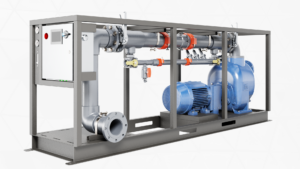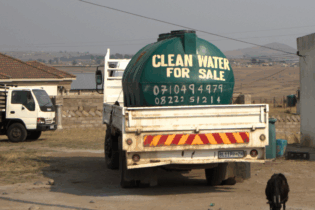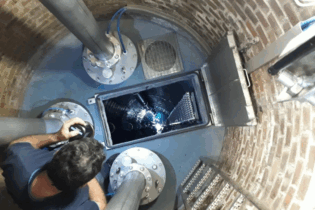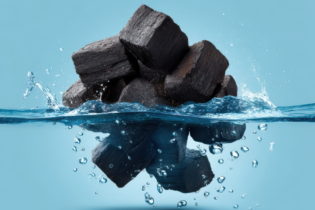BluePlanet has been appointed by Magalies Water to assist in the remediation efforts Hartbeespoort Dam. Armed with Nanobubble technology and a restorative plan, BluePlanet is addressing root causes rather than merely treating symptoms. WASA speaks to Rowan McDonald (RM), Head of Nanobubble Technology at BluePlanet South Africa.
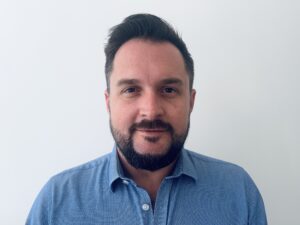 Bioremediation lies at the heart of BluePlanet. What is bioremediation and why should we consider these solutions in water and wastewater treatment?
RM: Bioremediation restores health and balance to ecosystems affected by pollution using a nature-based approach. In water contexts, it involves encouraging beneficial microbes and enzymes to handle excess nutrients, suspended solids, and sludge, and to create conditions that support resilient
Bioremediation lies at the heart of BluePlanet. What is bioremediation and why should we consider these solutions in water and wastewater treatment?
RM: Bioremediation restores health and balance to ecosystems affected by pollution using a nature-based approach. In water contexts, it involves encouraging beneficial microbes and enzymes to handle excess nutrients, suspended solids, and sludge, and to create conditions that support resilientmicrobial communities against pollution. Unlike chemical processes that offer rapid but short-lived results and may harm non-target organisms, bioremediation uses naturally occurring species and biological reactions. This method takes longer but achieves sustainable results by establishing ecological balance and resilience. BluePlanet has implemented bioremediation in various global projects, using acclimatised formulations of beneficial microbes and enzymes. The
integration of nanobubble technology has significantly improved timelines and results. Locally, we have worked on the Kuils, Eerste, and Soet Rivers in Cape Town, the biodiversity plan of the Nyl Dam in Mokapone, and an emergency intervention at Roodeplaat Dam in Pretoria for the 2023 World Rowing Masters Regatta. Our approach is applied to the inlets and outlets of wastewater treatment plants and for environmental clean-ups, such as oil and sludge spills. Why are so many of our rivers, dams, wetlands and lakes ‘unbalanced’? According to the Green Drop Report, a significantly high number of municipal wastewater systems are now rated as critical, meaning that many of our rivers and dams are overloaded with poorly treated wastewater. These ecosystems do not have the ability to deal with this loading of organic and inorganic pollutants and this leads to eutrophication. Layers of sludge begin to settle at the bottom of the water body. This is typically an anaerobic environment at the sediment layer where the water meets the sludge. Here, microbes are largely inactive or slow to digest the nutrient bed due to the lack of oxygen. This triggers a state of flux where nutrients mobilise from the sediment back into the water column. Excess biomass in suspended form (harmful algae blooms) or floating invasives like water hyacinth and water lettuce grow as they feed off these nutrients, triggering a vicious cycle of dissolved oxygen extremes through the diurnal cycle and lack of sunlight interaction. These conditions cause fish die-offs, foul odours and a continuation
of the nutrient bulking. pH and redox potential are unstable at the sediment interface and this continues the fluxing of nutrients causing the symptoms we see. One such example is Hartebeespoort Dam, where Blueplanet’s bioaugmentation program is using Nanobubble technology to reverse this hypertrophic condition. Please elaborate.
 At least 10 malfunctioning wastewater treatment plants (WWTPs) among other nutrient sources affect the tributaries of Hartebeespoort Dam. Even if these WWTPs are repaired, the rivers and dam may remain compromised due to decades of pollution, resulting in sludge buildup, volatile water chemistry, and high levels of nitrate and phosphorus. To restore balance, the sludge needs to be digested, sediment firmed up, and water chemistry stabilised to restore the biological balance and control dissolved oxygen concentration volatility and the mobilisation of nutrients. Essentially, we are introducing oxygen into the dam to create favourable conditions for beneficial microbes to thrive and generally out-compete the ‘bad bacteria’. It speeds up the bioremediation process.
At least 10 malfunctioning wastewater treatment plants (WWTPs) among other nutrient sources affect the tributaries of Hartebeespoort Dam. Even if these WWTPs are repaired, the rivers and dam may remain compromised due to decades of pollution, resulting in sludge buildup, volatile water chemistry, and high levels of nitrate and phosphorus. To restore balance, the sludge needs to be digested, sediment firmed up, and water chemistry stabilised to restore the biological balance and control dissolved oxygen concentration volatility and the mobilisation of nutrients. Essentially, we are introducing oxygen into the dam to create favourable conditions for beneficial microbes to thrive and generally out-compete the ‘bad bacteria’. It speeds up the bioremediation process.
technology – Moleaer. There are a number of nanobubble technology companies, but we chose Moleaer for their scalable, low-maintenance method of generation. You get nanobubbles and then you have Moleaer nanobubbles – the scale and performance are years ahead of the young industry. Their technology includes a water pump, a gas source (air compressor or oxygen concentrator), and a nanobubble generator core, which dissolves gas into water and generates nanobubbles. The nanobubble generator has no moving parts and the core itself does not even need electricity to operate. Electrical requirements come from the pumping of water and low pressure air/oxygen supply. Sizes vary from 9 m3/hour to 1000 m3/hour per module and multiple modules can be deployed. Given the cost and effort that goes into aeration at a WWTP, introducing oxygen into a huge water body like Hartebeespoort Dam must be a mammoth task.
 Typically it would if using traditional aeration technology. Nanobubbles shouldn’t be confused with ‘aeration’. The technology is selective in its mass
Typically it would if using traditional aeration technology. Nanobubbles shouldn’t be confused with ‘aeration’. The technology is selective in its masstransfer and hyper efficient. The average WWTP uses between 600 kW and 1600 kW/Mℓ of water. With nanobubble technology, we are turning 40 kW/Mℓ of water at Hartebeespoort Dam but don’t need to hydraulically turnover the whole dam. The treatment effects spread well beyond what has passed through the system. Nanobubbles are 70-120 nanometers in size and invisible to the naked eye. Around a billion fit on the tip of a finger. Unlike typical bubbles, they are neutrally buoyant, hydrophobic, and subject to Brownian motion, allowing them to fill the water collumn and infiltrate sediment. Nanobubbles are drawn to pollutants and interaction with the sediment. Oxygen can therefore be introduced at depth, where its needed without
disturbing sediment. This creates an aerobic environment conducive to microbial nutrient digestion and cycling, stabilising the system. Increased redox
potential encourages phosphorus binding and supports the ammonia nitrogen cycle, with improvements already seen at Hartebeespoort Dam. Our focus is on the Swartspruit inlet as part of a scaling pilot over an 85-hectare area to determine remediation needs for the entire dam. This is not an experiment; the technology is proven in environmental applications. BluePlanet’s efforts are part of a broader strategy by Magalies Water and the Department of Water and Sanitation (DWS) where short-, medium- and long-term interventions include source point pollution tracking, hyacinth and debriremoval, bio control agents by Rhodes University, in-situ studies and upstream efforts to control pollution. Nanobubble technology is crucial for medium and long-term nutrient impact reduction and dam rehabilitation. Where else can nanobubble technology be used? Moleaer Nanobubble technology has fast proven itself valuable in sectors like mining, oil and gas, water reclamation, membrane optimisation, irrigation,
and aquaculture. Nanobubbles have been successfully used as pre-treatment in the headworks of wastewater treatment plants, especially with the increased use of chemicals and surfactants due to COVID-19 and stringent food and beverage industry standards. These substances hinder biological
treatment by keeping solids suspended and targeting microbes (good and bad). Installing a nanobubble generator at a WWTP’s inlet targets the oxidation of inhibitory compounds early, improving separation and reducing aeration energy. At the WWTP discharge, ozone nanobubbles can replace chemicals,
add oxygen and promote the growth of healthy microbes in receiving rivers and dams. For potable plants dealing with eutrophic water, nanobubble technology with ozone is an ideal pre-treatment for addressing algae and toxins.


